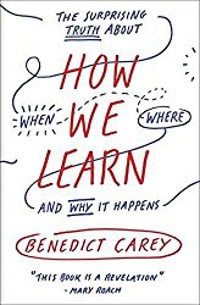Just think about it deeply, then forget it…then an idea will jump up in your face.
So said Don Draper in the first season of Mad Men. Those words contain one of the most important (and often hardest to learn) lessons of creativity.
Let Go!
That’s right, one of the most vital skills required to be productively creative is knowing how and when to just let go.
Before I learned this, I used to get discouraged and down on myself quite often when trying to create.
In my current role at CableLabs I am (very) often responsible for creating presentations on a wide variety of topics surrounding the Internet and computer networking. No, this isn’t fine art, but it is a creative endeavor. I approach everything I do as a creative art form. I back my work with hard science, engineering, and research, but I try to think like an artist, an inventor, and an entrepreneur, every day. Constantly in fact.
My process typically looks something like this:
- Brainstorm for content
- Organize for flow
- Research
- Re-organize as needed
- More research
- Create content
- Final clean up
The most frustrating part of this flow used to lie somewhere around the research and the content creation.
Let’s say I sit down on Monday morning with my team to brainstorm. Monday afternoon I crank out a slide template, basically an outline, or a story board, based on our selected brainstorming ideas. Then on Tuesday I stare at the template, dig into the covered topics, stare some more… Wednesday is the same; staring, reading, thinking, trying to put something into the slides but coming up empty. This is where that discouragement, frustration or disappointment starts to kick in. Sometimes its fear: “Oh shit, this presentation is on Friday and I’ve got nothing!” So I give up. Thursday I work on other stuff. Now all of a sudden it’s Friday morning. I have no choice, I must finish the slides – NOW. I open the file… And out pours this stream of genius (if I do say so myself) content! The slides are done in 20 minutes. The team reviews everything, we do final clean up, and the presentation’s a hit.
But I feel like a lazy bastard. In my mind, I did nothing all week and was able to pull together the needed presentation in 20 minutes. If I can do that, imagine how much I could get done if I hadn’t wasted all that time before I did the real work, right?
Wrong.
Fact is, all that research and concentration earlier in the week needed time to gestate in my brain. The only reason I was able to pump a great presentation out in 20 minutes is because of all that prep work – not despite it. This is the secret of letting go.
 And it’s true regardless of your chosen creative endeavor. You can’t force creativity. You must do exactly as Don said: Focus. Let go. Create. Then you repeat as needed. It’s when you let go, focus your thoughts on something else, that the deeper parts of your brain get their chance to do the hard work for you. Bits of data, fragments of ideas, parts of facts and figures, all coalesce. And when you return to the project, they flow out of you in ways that you could not have consciously conceived. It’s a metamorphosis of sorts. You must feed the caterpillar but you must also let her crawl away and sleep in the cocoon. You must, that is, if you want to discover the butterfly.
And it’s true regardless of your chosen creative endeavor. You can’t force creativity. You must do exactly as Don said: Focus. Let go. Create. Then you repeat as needed. It’s when you let go, focus your thoughts on something else, that the deeper parts of your brain get their chance to do the hard work for you. Bits of data, fragments of ideas, parts of facts and figures, all coalesce. And when you return to the project, they flow out of you in ways that you could not have consciously conceived. It’s a metamorphosis of sorts. You must feed the caterpillar but you must also let her crawl away and sleep in the cocoon. You must, that is, if you want to discover the butterfly.
Take a break!
I am now conscience of this need to pause and let my brain do it’s thing. I plan for it. I build my daily rituals and my work habits around this simple truth. I make letting go a frequent and regular part of my schedule. One of the best ways to do this is by breaking up your work.
Psychology Today has this to say about taking breaks:
Taking breaks actually enhances the development of strength. Termed hormesis, we find this principle at work in at least two important biological systems. Muscles grow and become stronger in response to stress (that is, working out) as long as the stress is followed by adequate rest. Recently, we’ve learned that neurons become more resistant to diseases like epilepsy, migraines, and even dementia when stressed and then allowed a period of rest. The thing that stresses neurons and thus ultimately leads to their increased hardiness? Thinking.
So there you have it, the brain needs exercise and rest, just like the body.
Right about now you’re probably asking yourself “how often should I take these needed breaks?” Well, bestselling author Tony Schwartz has this to say:
First of all, I would say you want to work in increments of no more than 90 minutes. You don’t have to work 90 minutes.
Why is it magical? Because there is a rhythm in our bodies that operates in 90-minute intervals. That rhythm is the ultradian rhythm, which moves between high arousal and fatigue.
OK, but how to give your brain that break? I find that the best way to refresh myself is with a short burst of physical stimulation. I also try to switch my breaks up a bit so that I’m not always doing the same thing. Here’s a list of ideas for break activities that will take your focus off of the current project, without wasting your whole day:
- Grab a bite to eat
- Do some pushups
- Do some pull-ups
- Do some sit-ups
- Do some jumping jacks
- Jump on a trampoline
- Walk a slack line
- Dance!
- Ride a bike
- Ride a skateboard
- Ride a scooter
- Ride a unicycle
- Swing (bonus for a tire swing in a tree)
- Hang upside down
- Masturbate (not recommended for office workers)
- Light a fire (safely and in a designated fireplace please – I take no responsibility for your stupidity)
- Walk away (sometimes you just need to skip out for a while and go do something completely different)






[…] My process typically looks something like this: Brainstorm for content In my current role at CableLabs I am (very) often responsible for creating presentations on a wide variety of topics surrounding the Internet and computer networking. No, this isn’t fine art, but it is a creative endeavor. I approach everything I do as a creative art form. Give Up to Get Creative […]